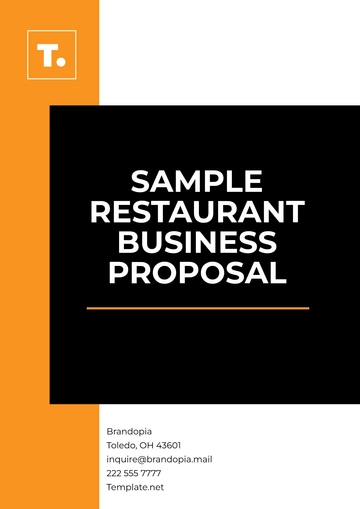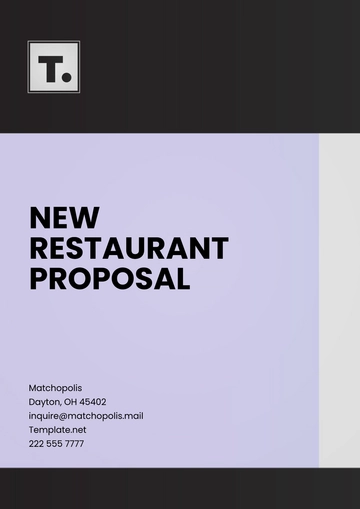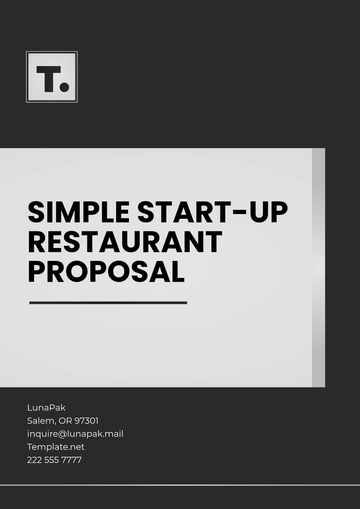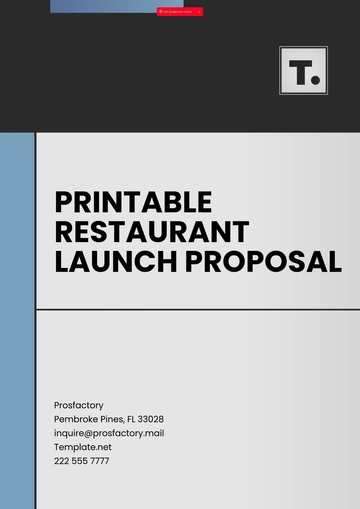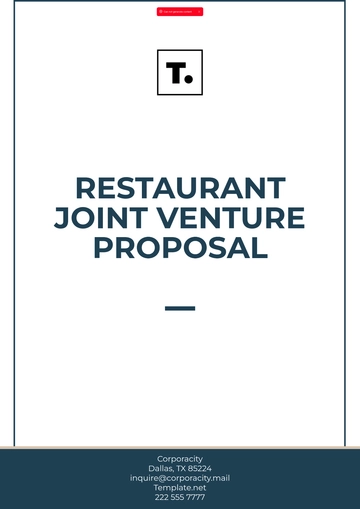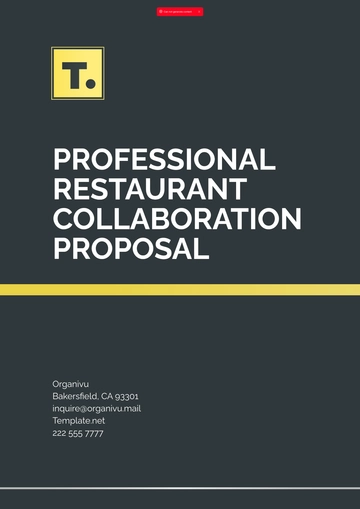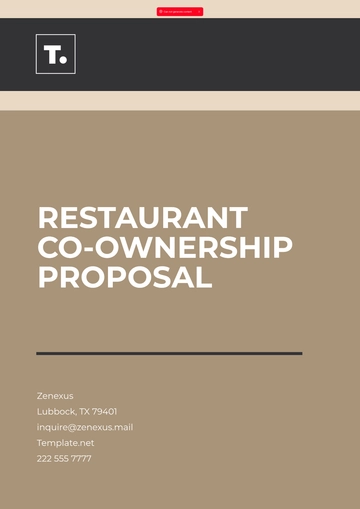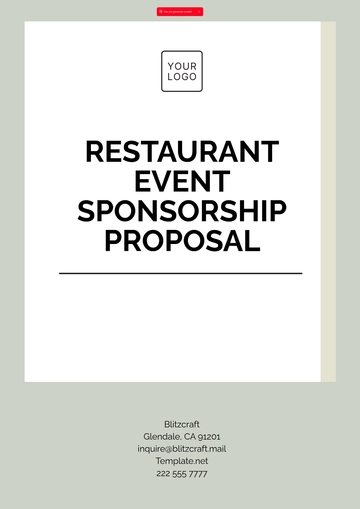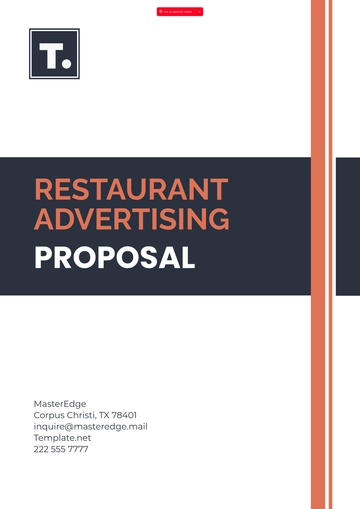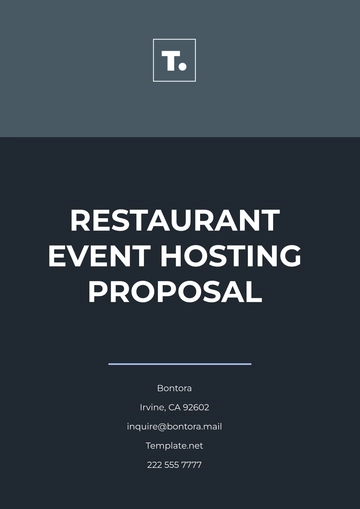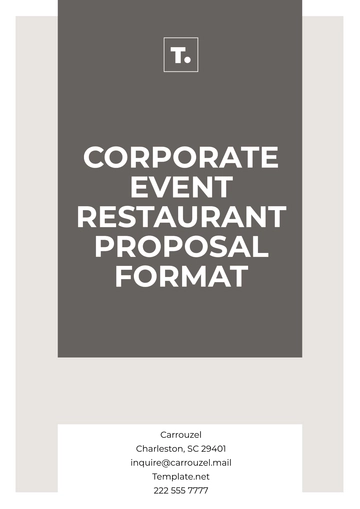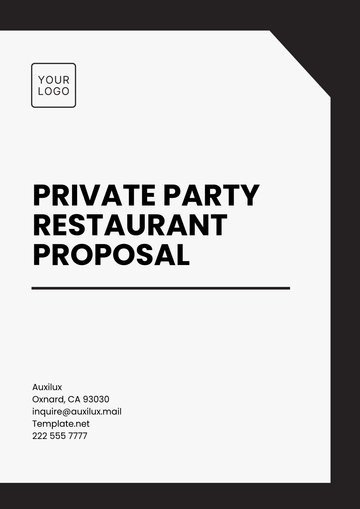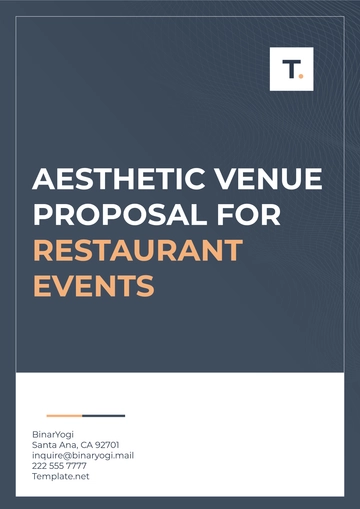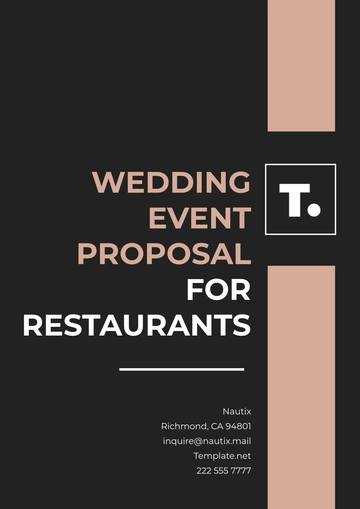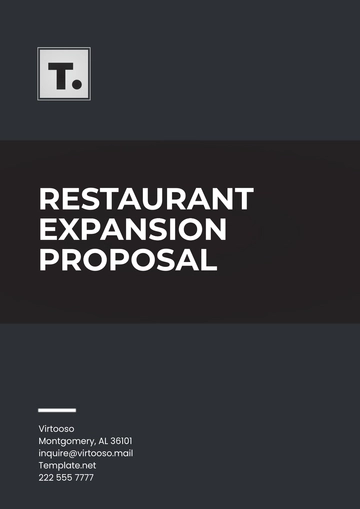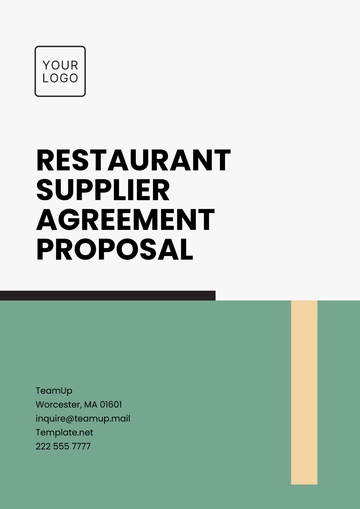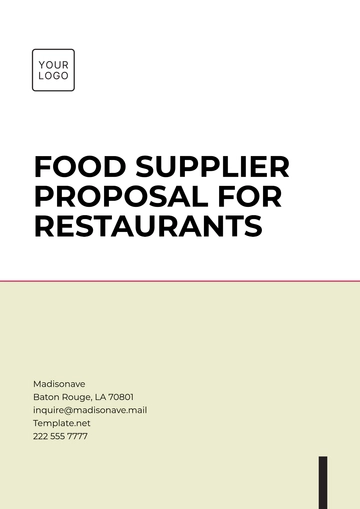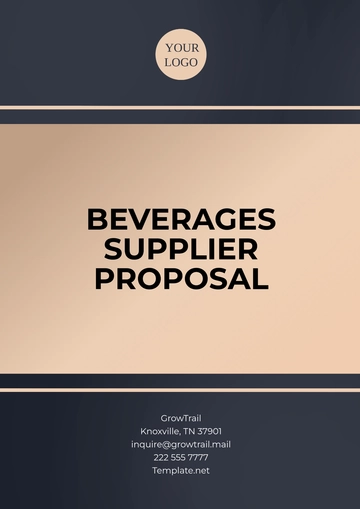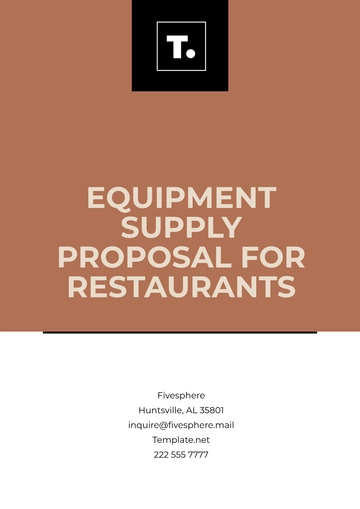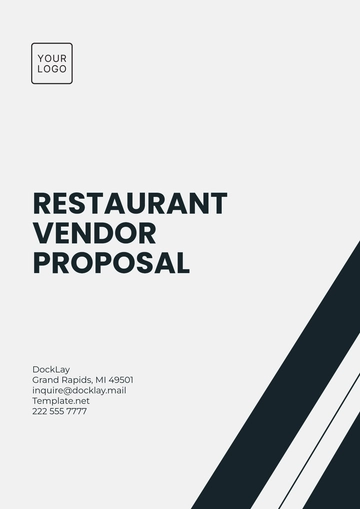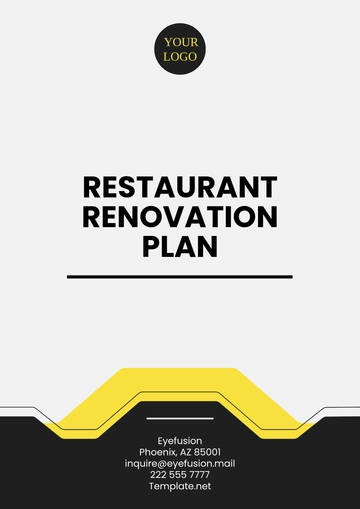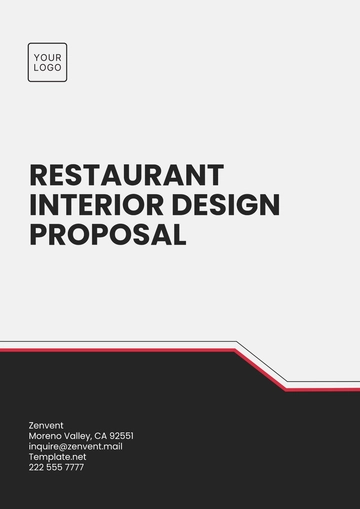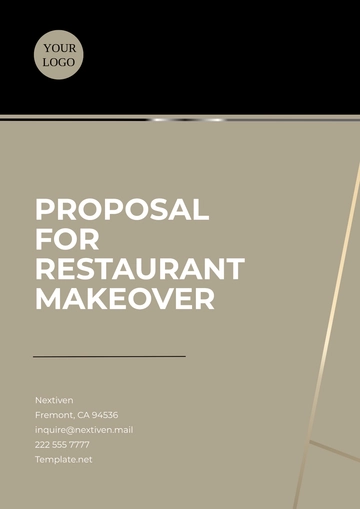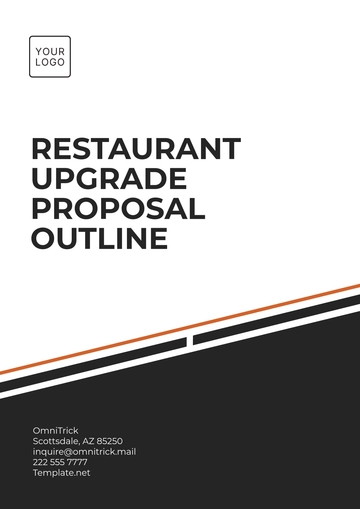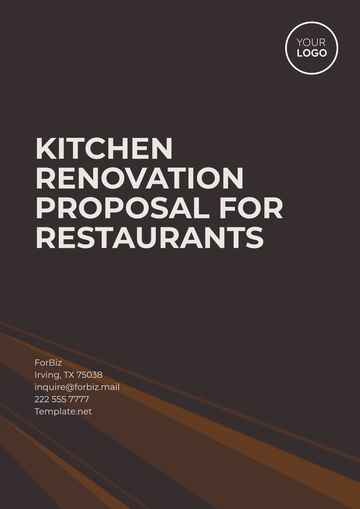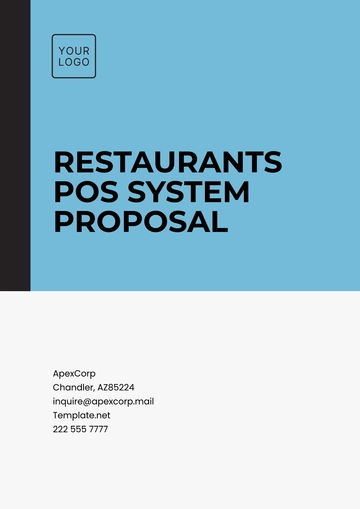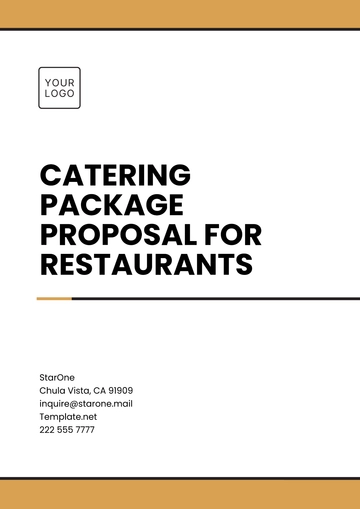Free Restaurant Budget Proposal
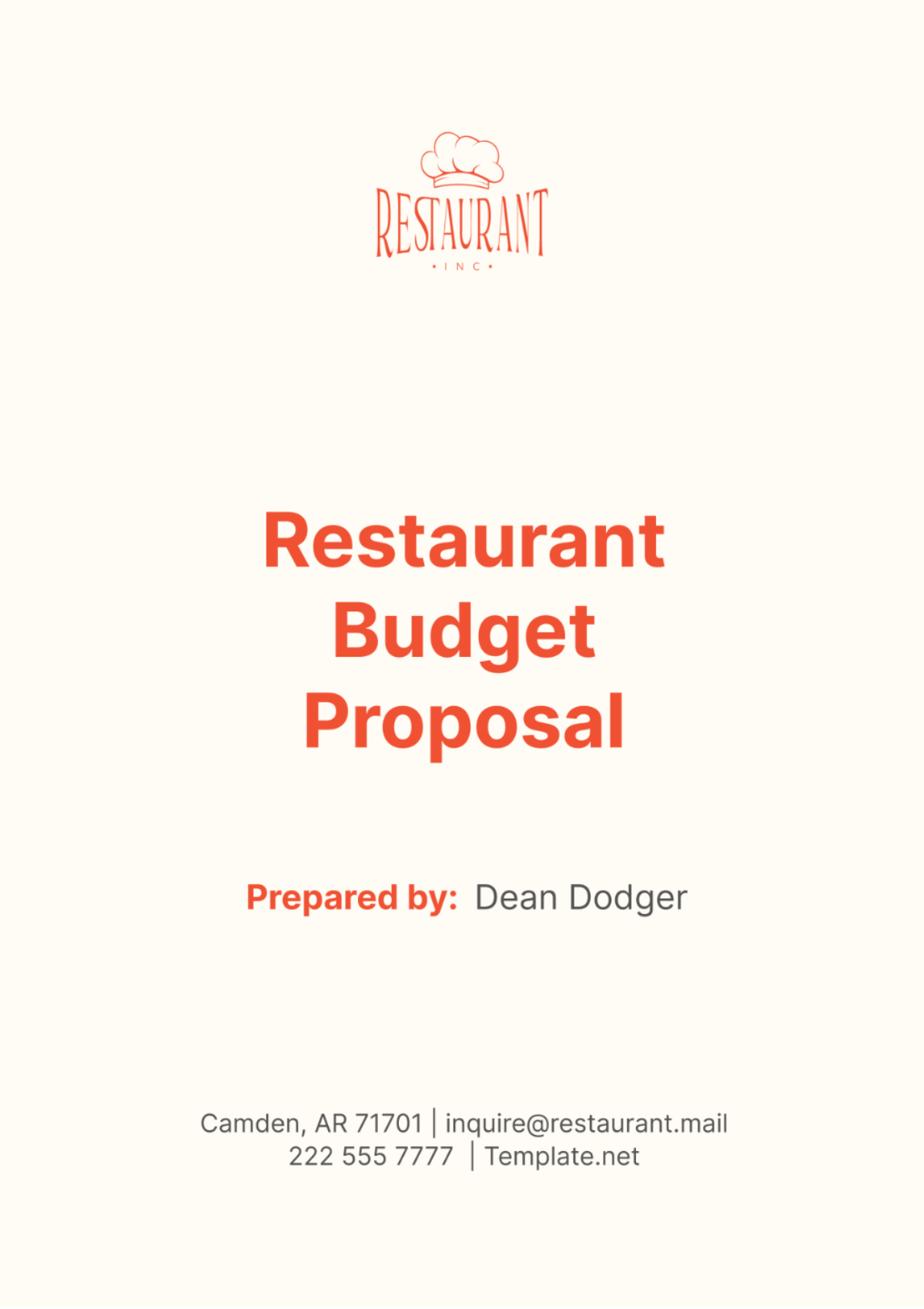
I. Executive Summary
A. Restaurant Overview
Name and Location: [Your Company Name] is strategically located at [Your Company Address] in the heart of [City], an area renowned for its vibrant dining scene and diverse culinary offerings.
Concept and Cuisine: Our restaurant blends classic French techniques with modern Asian flavors, creating a unique fusion cuisine that appeals to discerning palates. The ambiance is designed to provide an upscale yet welcoming dining experience, featuring elegant decor and a comfortable setting.
Mission and Vision: Our mission is to deliver an exceptional dining experience through innovative dishes and impeccable service, consistently exceeding our guests' expectations. Our vision is to become the top-rated fine-dining establishment in [City], known for our creativity, quality, and outstanding customer service.
B. Objectives
Financial Goals: Our primary financial goal is to achieve a 15% profit margin by the end of the fiscal year. We aim to increase our annual revenue by 20% through strategic marketing initiatives and expanding our customer base, while also reducing food waste costs by 10% through better inventory management.
Operational Goals: We plan to enhance customer satisfaction scores by 25% by improving service quality and implementing customer feedback systems. Additionally, we will introduce a new reservation system by Q2 to streamline bookings and reduce wait times, and strive to maintain a staff retention rate of 90% by fostering a positive and supportive work environment.
II. Sales Projections
A. Revenue Estimates
Monthly Sales Projections: We anticipate steady growth in sales, starting with $[00,000] in January and increasing to $[00,000] in February, and $[00,000] in March, with peak months expected during the holiday season. This growth is based on historical data, marketing efforts, and planned promotional events.
Month
Projected Sales ($)
January
[00,000]
February
[00,000]
March
[00,000]
April
[00,000]
May
[000,000]
June
[000,000]
July
[000,000]
August
[000,000]
September
[000,000]
October
[000,000]
November
[000,000]
December
[000,000]
Total
[0,000,000]
Quarterly Sales Projections: Our projections indicate a gradual increase each quarter: $[000,000] in Q1, $270,000 in Q2, $[000,000] in Q3, and $[000,000] in Q4. These estimates reflect seasonal trends and anticipated boosts from special events and holiday dining.
Quarter
Projected Sales ($)
Q1
[000,000]
Q2
[000,000]
Q3
[000,000]
Q4
[000,000]
Total
[0,000,000]
B. Sales by Category
Food Sales: Annual food sales are projected at $[000,000], driven by our diverse and appealing menu. We expect an average of $[00,000] per month from food sales, bolstered by seasonal menu changes and special promotions.
Beverage Sales: Beverage sales, including wine, cocktails, and non-alcoholic drinks, are projected to generate $[000,000] annually. We anticipate $[00,000] in monthly beverage sales, supported by our curated drink menu and promotional events like happy hours and wine tastings.
Other Revenue Streams: Our catering services are expected to bring in an additional $[00,000] annually, capitalizing on corporate events and private parties. Merchandise sales, including branded items and gift cards, are projected at $[00,000] annually, providing a steady supplementary income.
Category | Annual Revenue ($) | Monthly Average ($) |
|---|---|---|
Food Sales | [000,000] | [00,000] |
Beverage Sales | [000,000] | [00,000] |
Other Revenue | ||
- Catering | [00,000] | [0,000] |
- Merchandise | [00,000] | [0,000] |
Total | [0,000,000] | [000,000] |
III. Cost of Goods Sold (COGS)
A. Direct Costs
Ingredients and Raw Materials: We have allocated an annual budget of $[000,000] for ingredients and raw materials, ensuring the highest quality for our dishes. This averages $[00,000] per month and includes premium meats, fresh produce, and specialty items sourced from trusted suppliers.
Beverage Inventory: An annual budget of $[00,000] is designated for our beverage inventory, including a diverse selection of wines, spirits, and craft beers. This budget ensures we can offer a wide range of high-quality beverages to complement our menu.
Cost Type
Annual Budget ($)
Monthly Average ($)
Ingredients & Raw Materials
[000,000]
[00,000]
Beverage Inventory
[00,000]
[0,000]
Total
[000,000]
[00,000]
B. Inventory Management
Ordering Procedures: We will implement a bi-weekly ordering system to maintain optimal inventory levels and ensure the freshness of our ingredients. By establishing strong relationships with our suppliers, we aim to negotiate favorable terms and reduce costs.
Waste Reduction Strategies: To minimize waste, we will introduce a waste tracking system and partner with local food banks. This approach not only helps reduce our food costs by 10% but also supports our commitment to sustainability and community engagement.
IV. Labor Costs
A. Staffing Plan
Front-of-House Staff: We plan to employ 15 servers, 3 hosts, and 2 bartenders, with a total annual budget of $[000,000]. This ensures we can provide excellent customer service and maintain smooth operations during peak hours.
Back-of-House Staff: Our kitchen team will consist of 10 staff members, including chefs and dishwashers, with an annual budget of $[000,000]. This budget allows us to attract and retain skilled culinary professionals.
Management Team: We will have 3 managers overseeing daily operations, customer service, and staff performance. With a budget of $[000,000] annually, we aim to ensure effective leadership and a well-coordinated team.
B. Compensation and Benefits
Wages and Salaries: Total annual wages and salaries are budgeted at $[000,000], reflecting competitive compensation to attract and retain top talent. This budget covers all employee categories, ensuring fair pay and job satisfaction.
Employee Benefits: We have allocated $[00,000] annually for employee benefits, including health insurance, paid time off, and other perks. This investment in our employees' well-being helps improve retention and morale.
Payroll Taxes: Payroll taxes are estimated at $[00,000] annually, ensuring compliance with all tax obligations and regulations.
C. Scheduling and Labor Efficiency
Shift Planning: We will utilize advanced scheduling software to optimize shift planning, ensuring adequate coverage during peak hours and minimizing labor costs. This approach helps maintain high service standards while controlling expenses.
Overtime Management: Overtime will be closely monitored and controlled, with an annual budget of $[00,000]. By managing overtime effectively, we can keep labor costs in check and avoid burnout among staff.
V. Operating Expenses
A. Fixed Expenses
Rent or Mortgage: We have budgeted $[000,000] annually for rent, based on our prime location in [City]. This expense is critical for maintaining our presence in a high-traffic area that attracts a steady flow of customers.
Utilities: Utilities, including electricity, water, and gas, are budgeted at $[00,000] annually. This estimate ensures we can cover the costs of maintaining a comfortable and efficient dining environment.
Insurance: We have allocated $[00,000] annually for insurance, covering property, liability, and worker’s compensation. Adequate insurance protects our business from potential risks and liabilities.
B. Variable Expenses
Marketing and Advertising: An annual budget of $[00,000] is set for marketing and advertising, focusing on social media campaigns, local events, and promotions. This investment aims to increase brand awareness and attract new customers.
Supplies and Smallwares: We have budgeted $[00,000] annually for supplies and smallwares, including cleaning products, tableware, and kitchen utensils. Keeping these items stocked ensures smooth and efficient operations.
Maintenance and Repairs: An annual budget of $[00,000] is allocated for maintenance and repairs to keep our equipment and facilities in top condition. Regular maintenance helps prevent breakdowns and extends the life of our assets.
C. Administrative Expenses
Office Supplies: Office supplies, including stationery, printing, and software subscriptions, are budgeted at $[0,000] annually. These expenses support our administrative functions and day-to-day operations.
Professional Fees: We have allocated $[00,000] annually for professional fees, covering legal, accounting, and consulting services. These experts provide essential guidance and support to ensure our business complies with regulations and operates efficiently.
VI. Capital Expenditures
A. Equipment Purchases
Kitchen Equipment: We plan to invest $[00,000] in new kitchen equipment, including ovens, refrigerators, and specialized appliances. This investment will enhance our kitchen’s efficiency and capacity to produce high-quality dishes.
Dining Room Furniture: An additional $[00,000] will be spent on new tables, chairs, and decor to refresh the dining room and improve the customer experience. This update aims to create a more inviting and comfortable atmosphere.
B. Renovations and Improvements
Interior Upgrades: We will allocate $[00,000] for interior upgrades, such as new lighting, flooring, and decor enhancements. These improvements are designed to modernize the restaurant’s look and feel, making it more attractive to diners.
Exterior Enhancements: A budget of $[00,000] is set aside for exterior enhancements, including patio improvements and facade updates. These changes will improve curb appeal and create a more inviting entrance for customers.
VII. Profit and Loss Statement (P&L)
A. Revenue
Total Sales: Our projected total sales for the year amount to $[0,000,000], based on detailed monthly and quarterly estimates. This figure includes revenue from food, beverages, catering, and merchandise sales.
B. Expenses
Expense Type | Annual Amount ($) |
|---|---|
COGS | [000,000] |
Labor Costs | [000,000] |
Operating Expenses | [000,000] |
Capital Expenditures | [000,000] |
Total Expenses | [0,000,000] |
COGS: The total annual Cost of Goods Sold is $[000,000]. This includes $[000,000] for ingredients and raw materials and $[00,000] for beverage inventory.
Labor Costs: Total labor costs are projected at $[000,000] annually, covering wages, benefits, and payroll taxes for all staff.
Operating Expenses: We have budgeted $[000,000] annually for operating expenses, including rent, utilities, insurance, marketing, supplies, and maintenance.
Capital Expenditures: Capital expenditures are estimated at $[000,000] for the year, covering kitchen equipment purchases and dining room and exterior improvements.
C. Net Profit or Loss
After accounting for all expenses, our projected net profit is $[000,000]. This reflects a profit margin of approximately 10%, aligning with our financial goals for the year.
VIII. Cash Flow Statement
A. Cash Inflows
Sales Revenue: Total sales revenue is projected to be $[0,000,000] for the year, with monthly inflows varying based on seasonal trends and promotional efforts.
Other Income: Additional income of $[00,000] is expected from interest and miscellaneous sources.
B. Cash Outflows
Operating Expenses: Annual operating expenses are projected at $[000,000], including COGS, labor costs, and other operating expenses.
Debt Payments: We have budgeted $[00,000] for debt payments, ensuring we meet all financial obligations.
C. Net Cash Flow
Our net cash flow for the year is projected to be positive at $[000,000], ensuring that we maintain a healthy cash reserve and can reinvest in the business as needed.
IX. Break-even Analysis
A. Fixed Costs
Fixed costs for the year are estimated at $[000,000], including rent, utilities, insurance, and other non-variable expenses.
B. Variable Costs
Variable costs, primarily COGS and some labor costs, total $[000,000] annually.
C. Break-even Point Calculation
To calculate the break-even point: Fixed Costs / (Sales Price per Unit - Variable Cost per Unit). For simplicity, assume an average sales price per unit of $[00] and a variable cost per unit of $[00].
D. Sales Volume Required to Break Even
The break-even point is calculated as $[000,000] / ($[00] - $[00]) = 14,400 units. Therefore, we need to achieve $[000,000] in sales to cover all fixed and variable costs and break even.
X. Contingency Plan
A. Risk Assessment
Market Risks: Potential risks include economic downturns, changes in consumer preferences, and increased competition in the area.
Operational Risks: These include equipment failures, supply chain disruptions, and staffing shortages that could impact service quality and operational efficiency.
B. Mitigation Strategies
Cost-Cutting Measures: In the event of revenue shortfalls, we will implement cost-cutting measures such as reducing non-essential expenses, renegotiating supplier contracts, and temporarily adjusting staffing levels.
Emergency Funding Sources: We will establish a line of credit and maintain an emergency cash reserve of $[00,000] to address unforeseen financial challenges and ensure business continuity.
- 100% Customizable, free editor
- Access 1 Million+ Templates, photo’s & graphics
- Download or share as a template
- Click and replace photos, graphics, text, backgrounds
- Resize, crop, AI write & more
- Access advanced editor
Discover the ultimate solution for crafting impeccable restaurant budgets with the Restaurant Budget Proposal Template from Template.net. This editable and customizable template, powered by an intuitive AI Editor Tool, simplifies financial planning. Effortlessly tailor projections, expenses, and contingency plans to your establishment's needs. Streamline budgeting processes and elevate financial management with this indispensable tool.
You may also like
- Business Proposal
- Research Proposal
- Proposal Request
- Project Proposal
- Grant Proposal
- Photography Proposal
- Job Proposal
- Budget Proposal
- Marketing Proposal
- Branding Proposal
- Advertising Proposal
- Sales Proposal
- Startup Proposal
- Event Proposal
- Creative Proposal
- Restaurant Proposal
- Blank Proposal
- One Page Proposal
- Proposal Report
- IT Proposal
- Non Profit Proposal
- Training Proposal
- Construction Proposal
- School Proposal
- Cleaning Proposal
- Contract Proposal
- HR Proposal
- Travel Agency Proposal
- Small Business Proposal
- Investment Proposal
- Bid Proposal
- Retail Business Proposal
- Sponsorship Proposal
- Academic Proposal
- Partnership Proposal
- Work Proposal
- Agency Proposal
- University Proposal
- Accounting Proposal
- Real Estate Proposal
- Hotel Proposal
- Product Proposal
- Advertising Agency Proposal
- Development Proposal
- Loan Proposal
- Website Proposal
- Nursing Home Proposal
- Financial Proposal
- Salon Proposal
- Freelancer Proposal
- Funding Proposal
- Work from Home Proposal
- Company Proposal
- Consulting Proposal
- Educational Proposal
- Construction Bid Proposal
- Interior Design Proposal
- New Product Proposal
- Sports Proposal
- Corporate Proposal
- Food Proposal
- Property Proposal
- Maintenance Proposal
- Purchase Proposal
- Rental Proposal
- Recruitment Proposal
- Social Media Proposal
- Travel Proposal
- Trip Proposal
- Software Proposal
- Conference Proposal
- Graphic Design Proposal
- Law Firm Proposal
- Medical Proposal
- Music Proposal
- Pricing Proposal
- SEO Proposal
- Strategy Proposal
- Technical Proposal
- Coaching Proposal
- Ecommerce Proposal
- Fundraising Proposal
- Landscaping Proposal
- Charity Proposal
- Contractor Proposal
- Exhibition Proposal
- Art Proposal
- Mobile Proposal
- Equipment Proposal
- Student Proposal
- Engineering Proposal
- Business Proposal

